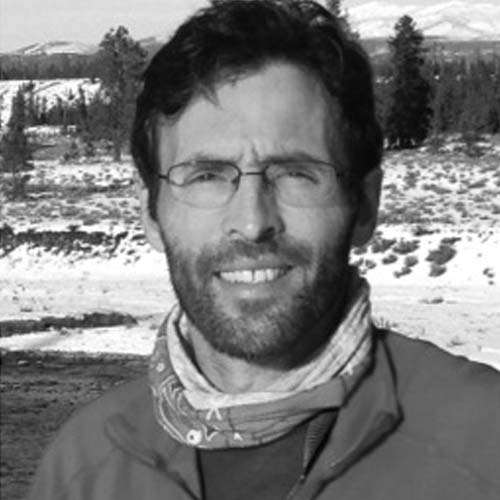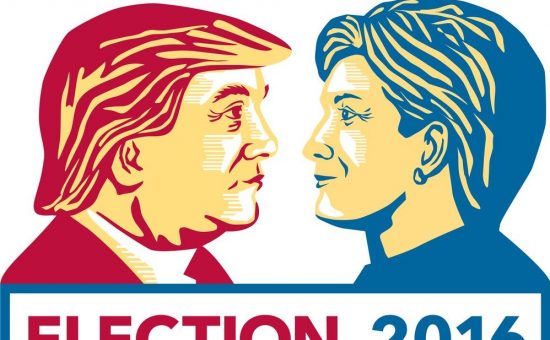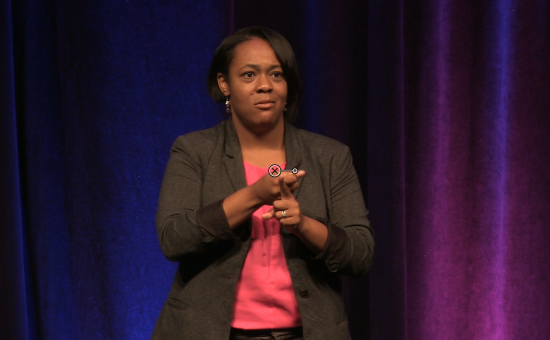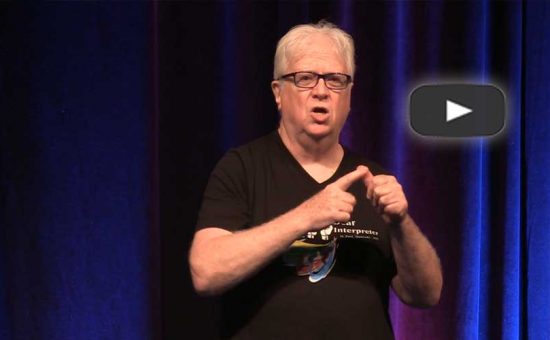Transforming Perspectives: The Power of One-to-One Conversations For Sign Language Interpreters
Doug Bowen-Bailey presented Transforming Perspectives: The Power of One-to-One Conversations For Sign Language Interpreters at StreetLeverage – Live 2014 | Austin. His talk suggested that one-one-one conversations with stakeholders in the Deaf and sign language interpreting communities can create powerful relationships that may transform our perspectives and lead to positive social change for both.
You can find the PPT deck for his presentation here.
[Note from StreetLeverage: What follows is an English version of Doug’s talk from StreetLeverage – Live 2014. We would encourage each of you to watch the video and access Doug’s talk directly.]
Redefining leverage
I am leverage.
That phrase may mean something different to all of us. I want to share with you what it means to me and how I see it’s relevance to our profession and community.
For many people, leverage may be seen as power or influence, much like tossing a stone into a pond and watching the ripples spread out in ever-widening circles. But for me, it is more than that. It is about capturing the energy so that it doesn’t spread out in all directions. Instead, leverage means we concentrate our power so that we are able to accomplish what, at first, may seem impossible. For those of us who are part of the Street Leverage experience (both at the live conference and taking part in the online blog), my perspective is that a passion for using our leverage for positive social change is a common thread.
Monkeys and Mavens
Thinking about leverage brings to mind a book I read in high school entitled, The Hundredth Monkey by Ken Keyes, Jr. In it, Keyes argued that human consciousness needed to reach a critical mass to prevent nuclear war and used the example of change among monkeys living on Japanese islands as an example of how that can happen.
The books’ premise is based on the observation of a group of Japanese monkeys who learned to wash sweet potatoes before eating them. Slowly, more and more monkeys on one specific island tried the new approach of washing the food before eating it. When the number of monkeys engaging in this activity reached a critical mass, termed the hundredth monkey phenomenon, all of the monkeys on the island starting doing it. But not only that, all of the others of the same species on different islands began washing the potatoes as well. In the writing of his book, Keyes believed that there was no contact between the groups – something that has later been debunked.
Yet this idea of critical mass led me to the work of Malcolm Gladwell and his book, “The Tipping Point,” which analyzes how ideas are spread. He shares multiple factors in the process, but for the purpose of this article, I want to focus in on what Gladwell terms “The Law of the Few.” He suggests there are three types of people within human social networks who play a special role in accelerating the spread of ideas. These roles he names as:
- Connectors
- Mavens
- Salespeople
Connectors are people who have relationships with an above average number of people and who seek to bring other people together if they seem to have a common purpose. For example, if you say that you are going to a city you have never visited before, a connector would be able to share the name of a person to visit in that city.
Mavens are people with in-depth knowledge of a certain topic. They are often the ones who generate ideas worth spreading, either by coming up with a new idea or uniquely blending together the ideas of others. They are people who have worked thoroughly through an idea or topic and are the person who comes to mind if you want some input on that topic. You will find the work of mavens of the interpreting field and the Deaf community in the pages of this blog.
Salespeople are the people in community who may not necessarily come up with their own idea, but are able to convey a message in such a way that makes sense to other people so they more readily adopt it.
It is important to note here, people are not exclusively one or another of these roles. We all may have some degree of connector, maven, and salesperson within us – and that may change depending on the context.
In order to make this idea more concrete, I think it is helpful to give an example related to the interpreting profession and I can’t think of a better one than Street Leverage, and its founder, Brandon Arthur. He has used the relationships he has with people (and his skill with technology and social media) to build a community of people who share thoughts. (This is the connector role.) He has brought together people with ideas worth sharing to write posts and present at Street Leverage ~ Live. (This is the maven role.) And Brandon uses his persuasive powers (both in his words and example) to inspire people to take part. At the most recent Street Leverage ~ Live, there were over 400 registrants and a tremendous team of Street Leverage staff (who are all volunteer.) To make this happen, you have to be a good salesperson.
The Rule of 150 and the Power of Weak Ties
In the spreading of ideas, Malcolm Gladwell offers another important insight from psychology. A number of studies have supported the conclusion that the human brain is wired to only be able to effective manage approximately 150 significant relationships – what Gladwell terms “The Rule of 150.” Gladwell suggests that organizations do well to keep these limits in mind as they structure themselves. If you move beyond that number, people don’t know each other well enough to feel a sense of loyalty and responsibility.
Gladwell suggests that a role connectors play is utilizing “the power of weak ties.” Connectors do not develop strong relationships with the numbers of people they know – rather they develop relationships for specific purposes and in certain contexts. These “weak ties” do have power in helping to spread ideas and strengthen community.
Social Media and Transforming Ideas
Social media, such as blogs, Facebook, and Twitter, can be powerful tools in supporting the work of connectors, mavens, and salespeople. Technology has empowered us to break the bonds of geography in that we can share our ideas around the globe to others who share our interest.
Yet the networks that we, as interpreters and the Deaf community, create are a drop in the cyber-bucket. As I write this, StreetLeverage has 2,129 followers on Twitter. LeBron James, a star athlete of the National Basketball Association, has over 12.9 million followers. And while social media can convey a variety of really meaningful ideas, it also has just as many or more distractions, such as quizzes to find out what Disney character you are most like? (For the record, it was my partner who took the quiz, not me.)
So, as people interested in change, how do we ensure that our messages remain a clear signal rather than becoming part of the noise of social media environments? It is here that I think our field can learn from the work of community organizers.
The Power of One-on-One Conversations
In the midst of all the distractions of the information superhighway, it is our relationships with people and causes that help us to focus our attention. Community organizers use the technique of intentional one-on-one conversations to develop relationships with specific people to increase their own influence – and to learn from others.
These intentional conversations can be used in a variety ways. Some are focused on specifically building relationships and learning about the interests and motivations of the individual you are having the conversation with. Other conversations may focus on gaining wisdom and insight, while a third type might focus on persuading a person to join action.
This past year, I undertook a project of my own to do a combination of the first two types of conversations. Inspired by the idea of “The Hundredth Monkey,” I called it “The Hundred Conversations Project” and invited interpreters, educators, and members of the Deaf community to have an hour long conversation with me related to our field. I used the framework of a SWOT analysis asking people to share their insights with me about what the Strengths, Weakness, Opportunities, and Threats for our profession are. I was clear in my invitation that my goal was not research, but to build relationship and to see if this could lead to a change in how interpreters relate to each other and the Deaf community.
While I am nowhere near the number of 100 conversations, I have learned much from the people who have accepted my offer. A number of themes emerged in conversations and as I move forward with the project, I hope to be able to offer a clearer picture of what I have learned. Some of the themes are very similar to those that are discussed through StreetLeverage such as:
- Nurturing new interpreters
- Transition from Service to Business Model
- Accountability to Deaf community
- Understanding Power & Privilege
- Making interpreting choices transparent
The point is not so much what I have learned, but that having intentional conversations such as these are powerful ways that we all can use to transform our own perspectives and build our relationships with others in the field.
Because, in the end, for people attending the StreetLeverage – Live events, or those who participate in this online forum, we all are interested in being part of the change and addressing the challenges that face our profession and communities.
Poets and the People
In thinking about this, I was reminded of the words of James Baldwin, a writer who because of how the United States treated the reality that he was African-American and gay, chose to live for a significant portion of his life in France. He shared these thoughts about change:
The poet or the revolutionary is there to articulate the necessity, but until the people themselves apprehend it, nothing can happen … Perhaps it can’t be done without the poet, but it certainly can’t be done without the people. The poet and the people get on generally very badly, and yet they need each other. The poet knows it sooner than the people do. The people usually know it after the poet is dead; but that’s all right. The point is to get your work done, and your work is to change the world.
In the framework of Gladwell, perhaps Baldwin’s poet is a “maven” and our work is to figure out how we can be connectors and salespeople to have the ideas spread to the people.
In the end, I think there needs to be a foundation of hope that the message will spread. Another poet, Clayton Valli, shared this message in his poem, The Dandelion, in which the great efforts of a gardener who sought to eradicate this “weed” only served to help spread its seeds.
Together, using the power of conversation and connection, we can come together to determine what ideas are worth spreading, and work together to transform ourselves and the world we live in. In the end, we will find that together, we are leverage.
What’s the first conversation you want to have on this journey to transformation?













